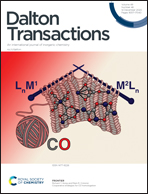A black-box approach to the construction of metal-radical multispin systems and analysis of their magnetic properties†
Abstract
An interaction of M(hfac)2 (M = Mn or Ni) with N-(bis(4,4,5,5-tetramethyl-3-oxido-1-oxyl-4,5-dihydro-1H-imidazol-2-yl)methylene)-2-methyl-propan-2-amine oxide (a nitronyl nitroxide diradical with the >C![[double bond, length as m-dash]](https://www.rsc.org/images/entities/char_e001.gif) N(O)–tert-Bu coupler) was investigated under various conditions. It was found that prolongation of reaction time caused transformation of the initial diradical into new diradicals with the unique >C
N(O)–tert-Bu coupler) was investigated under various conditions. It was found that prolongation of reaction time caused transformation of the initial diradical into new diradicals with the unique >C![[double bond, length as m-dash]](https://www.rsc.org/images/entities/char_e001.gif) N–OH coupling unit and formation of binuclear Mn(II) and Ni(II) complexes, which were characterized by X-ray diffraction analysis. The resulting binuclear heterospin complexes have a complicated magnetic structure with six paramagnetic centers and a number of exchange interaction channels between them, as well as between neighboring complexes. To adequately describe the magnetic properties of these complexes, high-level ab initio calculations of their electronic structure and parameters of the spin-Hamiltonian were carried out. The accuracy of the conventional broken-symmetry density functional theory approach in the calculation of the exchange interaction parameters was also verified.
N–OH coupling unit and formation of binuclear Mn(II) and Ni(II) complexes, which were characterized by X-ray diffraction analysis. The resulting binuclear heterospin complexes have a complicated magnetic structure with six paramagnetic centers and a number of exchange interaction channels between them, as well as between neighboring complexes. To adequately describe the magnetic properties of these complexes, high-level ab initio calculations of their electronic structure and parameters of the spin-Hamiltonian were carried out. The accuracy of the conventional broken-symmetry density functional theory approach in the calculation of the exchange interaction parameters was also verified.



 Please wait while we load your content...
Please wait while we load your content...